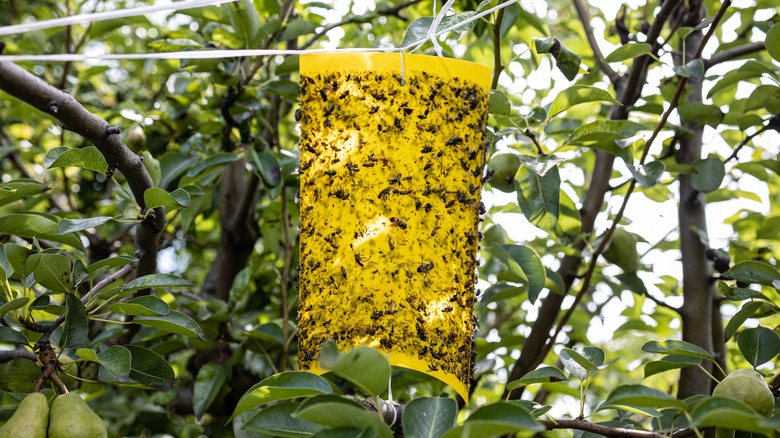The Hidden Dangers Of Using Sticky Traps To Keep Pests Out Of Your Bird Feeder
Sticky traps are a great way to keep pests out of both plants and bird feeders, but while they might be a godsend to stop fungus gnats from swarming around your vegetable garden, they have hidden dangers when it comes to birds themselves. Specifically, our feathered friends can get stuck on the sticky traps. They can then either become injured trying to detach from them, or die in the feeder if they can't get away before help arrives.
The problem occurs because birds eat insects in addition to seeds. The sticky paper trap looks like another buffet option for them to snack on, and they swoop in, trying to remove the bugs attached to the paper. However, if they make contact with the trap, the glue will catch them in place. Frightened, the bird will use a large amount of energy to try to remove itself from the trap, and this can eventually lead to death by exhaustion. If it does get away, it can lose its flight feathers, break bones, or tear skin. To keep the birds safe, opt for items like insect moats and guards instead of sticky traps.
What to use other than glue traps
To keep ants out of your birdfeeder, you can buy an ant moat that attaches to it, which will create a water barrier the little critters can't cross. If you have a hummingbird feeder and bees or wasps are your issue, swap your old feeder for one with a bee guard. This type of thick mesh will prevents these pests from getting to the nectar inside. But hummingbirds, with their long beaks, can still easily access the goods within without issue.
To keep flies from bothering the bird seed, make sure to clean the feeder frequently. Pour out the old seed every other day, give the tray a quick scrub to clean off any feces or grime that might attract flies, and refill it with fresh snacks. This will keep the bugs from congregating. For the same reason, be sure to clean up any bird droppings or debris below the feeder.
You can also set up a fly and bug feeder as a diversion. Fill it with sugary water and place it in a sunny, easy-to-spot part of your yard. Choose a yellow bug feeder to attract even more insects. The best place to hang a bird feeder is somewhere undisturbed by noise or activity, so keep it well away from your fly and bug feeder. The bugs will go wherever it's the easiest to feast, deterring them from the birds' food.
